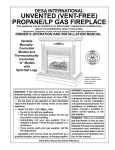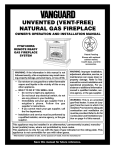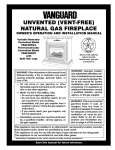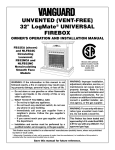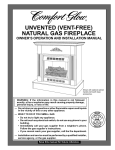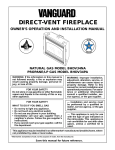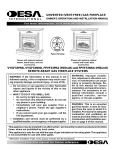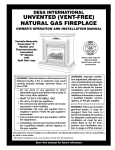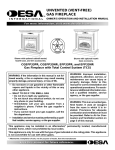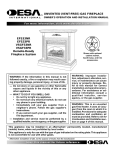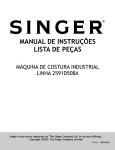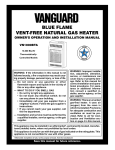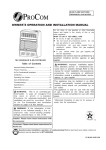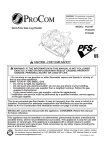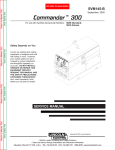Download Desa UNVENTED (VENT-FREE) PROPANE GAS FIREPLACE User's Manual
Transcript
DESA INTERNATIONAL UNVENTED (VENT-FREE) PROPANE GAS FIREPLACE OWNER’S OPERATION AND INSTALLATION MANUAL Manually Controlled ® ¢¢¢¢¢¢ ,,,,,, QQQQQQ ,,,,,, QQQQQQ ¢¢¢¢¢¢ ,,,,,, QQQQQQ ¢¢¢¢¢¢ ,,,,,, QQQQQQ ¢¢¢¢¢¢ ,,,,,, QQQQQQ ¢¢¢¢¢¢ ,,,,,, QQQQQQ ¢¢¢¢¢¢ ,,,,,, QQQQQQ ¢¢¢¢¢¢ ,,,,,,,,,, QQQQQQQQQQ ¢¢¢¢¢¢¢¢¢¢ ,,, QQQ ¢¢¢ ,,,,,, QQQQQQ ¢¢¢¢¢¢ ,,,,,,,,,, QQQQQQQQQQ ¢¢¢¢¢¢¢¢¢¢ ,,, QQQ ¢¢¢ ,,,,,, QQQQQQ ¢¢¢¢¢¢ ,,,,,,,,,, QQQQQQQQQQ ¢¢¢¢¢¢¢¢¢¢ ,,, QQQ ¢¢¢ Shown with optional cabinet mantel, hearth base, and trim accessories. WARNING: If the information in this manual is not followed exactly, a fire or explosion may result causing property damage, personal injury, or loss of life. — Do not store or use gasoline or other flammable vapors and liquids in the vicinity of this or any other appliance. — WHAT TO DO IF YOU SMELL GAS • Do not try to light any appliance. • Do not touch any electrical switch; do not use any phone in your building. • Immediately call your gas supplier from a neighbor’s phone. Follow the gas supplier’s instructions. • If you cannot reach your gas supplier, call the fire department. — Installation and service must be performed by a qualified installer, service agency, or the gas supplier. WARNING: This is an unvented gas-fired heater. It uses air (oxygen) from the room in which it is installed. Provisions for adequate combustion and ventilation air must be provided. Refer to the Air for Combustion and Ventilation section in this manual. Save this manual for future reference. CONTENTS SECTION PAGE Safety Information ................................................................................... 2 Product Identification .............................................................................. 4 Local Codes ............................................................................................. 5 Unpacking................................................................................................ 5 Product Features ...................................................................................... 5 Air for Combustion and Ventilation ........................................................ 6 Installing .................................................................................................. 9 Check Gas Type ............................................................................... 9 Assembling and Attaching Brass Trim ............................................ 10 Installation Clearances ..................................................................... 11 Conventional Fireplace Installation ................................................. 11 Built-In Fireplace Installation .......................................................... 13 Installing Gas Piping to Fireplace Location ..................................... 15 Connecting Fireplace to Gas Supply ................................................ 17 Checking Gas Connections .............................................................. 18 Installing Logs .................................................................................. 20 Operating Fireplace ................................................................................. 22 Inspecting Burners ................................................................................... 25 Cleaning and Maintenance ...................................................................... 26 Troubleshooting ....................................................................................... 26 Technical Service .................................................................................... 30 Service Hints ........................................................................................... 30 Replacement Parts ................................................................................... 31 Specifications .......................................................................................... 31 Wiring Diagram ....................................................................................... 31 Accessories .............................................................................................. 32 Illustrated Parts Lists ............................................................................... 34-37 Warranty Information .............................................................................. Back Cover SAFETY INFORMATION WARNING ICON G 001 WARNINGS IMPORTANT: Read this owner’s manual carefully and completely before trying to assemble, operate, or service this fireplace. Improper use of this fireplace can cause serious injury or death from burns, fire, explosion, electrical shock, and carbon monoxide poisoning. WARNING ICON G 001 DANGER Carbon monoxide poisoning may lead to death! Carbon Monoxide Poisoning: Early signs of carbon monoxide poisoning resemble the flu, with headaches, dizziness, or nausea. If you have these signs, the fireplace may not be working properly. Get fresh air at once! Have fireplace serviced. Some people are more affected by carbon monoxide than others. These include pregnant women, people with heart or lung disease or anemia, those under the influence of alcohol, and those at high altitudes. Propane Gas: Propane gas is odorless. An odor-making agent is added to the gas. The odor helps you detect a gas leak. However, the odor added to the gas can fade. Gas may be present even though no odor exists. Make certain you read and understand all Warnings. Keep this manual for reference. It is your guide to safe and proper operation of this fireplace. 2 Safety Information continues on next page 101969 SAFETY INFORMATION Continued WARNING ICON G 001 WARNINGS Continued WARNING: Any change to this fireplace or its controls can be dangerous. 1. Use only propane gas. Do not convert fireplace to use different fuel type. 2. Do not place propane supply tank(s) inside any structure. Locate propane supply tank(s) outdoors. 3. If you smell gas • shut off gas supply • do not try to light any appliance • do not touch any electrical switch; do not use any phone in your building • immediately call your gas supplier from a neighbor’s phone. Follow the gas supplier’s instructions • if you cannot reach your gas supplier, call the fire department 4. This fireplace shall not be installed in a bedroom or bathroom. 5. Never install the fireplace • in a recreational vehicle • where curtains, furniture, clothing, or other flammable objects are less than 36 inches from the front, top, or sides of the fireplace • in high traffic areas • in windy or drafty areas 6. Do not use this fireplace as a wood-burning fireplace. Use only the logs provided with the fireplace. 7. Do not add extra logs or ornaments such as pine cones, vermiculite, or rock wool. Using these added items can cause sooting. Do not add lava rock around base. Rock and debris could fall into the control area of fireplace. 8. You must operate this fireplace with the fireplace screen in place. Make sure fireplace screen is in place before running fireplace. 9. This fireplace is designed to be smokeless. If logs ever appear to smoke, turn off fireplace and call a qualified service person. Note: During initial operation, slight smoking may occur due to log curing and fireplace burning manufacturing residues. 10. Avoid any drafts that alter burner flame patterns. Do not allow fans to blow directly into fireplace. Do not place a blower inside burn area of firebox. Ceiling fans may create drafts that alter burner flame patterns. Sooting and improper burning will occur. Sooting can settle on household surfaces outside the fireplace. 11. This fireplace needs fresh air ventilation to run properly. This fireplace has an oxygen depletion sensor (ODS) pilot light safety system. The ODS shuts down the fireplace if not enough fresh air is available. See Air for Combustion and Ventilation, pages 6 through 8. If fireplace keeps shutting off, see Troubleshooting, pages 26 through 30. 12. Do not run fireplace • where flammable liquids or vapors are used or stored • under dusty conditions 13. Do not use this fireplace to cook food or burn paper or other objects. 14. Never place any objects in the fireplace or on logs. 15. Fireplace front and screen becomes very hot when running fireplace. Keep children and adults away from hot surfaces to avoid burns or clothing ignition. Fireplace will remain hot for a time after shut-down. Allow surfaces to cool before touching. 16. Carefully supervise young children when they are in the room with fireplace. 17. Do not use fireplace if any part has been exposed to or under water. Immediately call a qualified service technician to inspect the fireplace and to replace any part of the control system and any gas control which has been under water. 18. Do not operate fireplace if any log is broken. Do not operate fireplace if a log is chipped (dime-sized or larger). 19. Turn fireplace off and let cool before servicing. Only a qualified service person should service and repair fireplace. 20. Operating fireplace above elevations of 4,500 feet may cause pilot outage. 3 101969 PRODUCT IDENTIFICATION Crossover Log (#3) Front Log (#2) Rear Log (#1) Front Burner Rear Burner Left Front Branch (#4) Gas Regulator Base Right Front Branch Control (#5) Knob Piezo Ignitor Figure 1 - Log Base Assembly Top Louver Assembly Top Outer Casing Firebox Hood Firebox Support Rear Access Door Screen Assembly Side Access Door Bottom Louver Assembly 4 Figure 2 - Fireplace 101969 LOCAL CODES Install and use fireplace with care. Follow all local codes. In the absence of local codes, use the latest edition of The National Fuel Gas Code ANSI Z223, also known as NFPA 54*. *Available from: American National Standards Institute, Inc. 1430 Broadway New York, NY 10018 National Fire Protection Association, Inc. Batterymarch Park Quincy, MA 02269 UNPACKING PRODUCT FEATURES 1. Remove trim kit and cartons containing logs from carton. Place the carton containing the fireplace unit on its back. Hold fireplace and pull the carton and pallet away. 2. Remove protective packaging applied to logs, log base assembly, and fireplace. You may not want to remove protective plastic on front of fireplace until after installing. This will protect fireplace from dust, debris, and damage during installation. 3. Check all items for any shipping damage. If damaged, promptly inform dealer where you bought fireplace. Operation This vent-free fireplace is clean burning. It requires no outside venting. There is no heat loss out a vent or up a chimney. Heat is generated by both realistic flames and glowing embers. The fireplace requires no electricity making it ideal for emergency back-up heat. Safety Device This fireplace has a pilot with an Oxygen Depletion Sensor Shutoff System (ODS). The ODS/pilot is a required feature for vent-free room heaters. The ODS system shuts off the fireplace if there is not enough fresh air. Piezo Ignition System This fireplace has a piezo ignitor. This system requires no matches, batteries, or other sources to light fireplace. Manual Control This fireplace has a manual control valve which allows the user to choose the heat setting that best suits his needs. The low, medium, or high setting may be selected by simply turning the control knob. 5 101969 AIR FOR COMBUSTION AND VENTILATION WARNING ICON G 001 WARNING This fireplace must have fresh air for proper operation. If not, poor fuel combustion could result. Read the following instructions to insure proper fresh air for this and other fuel-burning appliances in your home. Today’s homes are built more energy efficient than ever. New materials, increased insulation, and new construction methods help reduce heat loss in homes. Home owners weather strip and caulk around windows and doors to keep the cold air out and the warm air in. During heating months, home owners want their homes as airtight as possible. While it is good to make your home energy efficient, your home needs to breathe. Fresh air must enter your home. Fresh air enters the home through and around doors and windows. This may provide enough fresh air for combustion and ventilation. All fuel-burning appliances need fresh air for proper combustion and ventilation. Exhaust fans, fireplaces, clothes dryers, and fuel burning appliances draw air from the house to operate. You must provide adequate fresh air for these appliances. This will insure proper venting of vented fuel-burning appliances. PROVIDING ADEQUATE VENTILATION The following are excerpts from the National Fuel Gas Code NFPA 54/ANSI Z223.1, Section 5.3, Air for Combustion and Ventilation. All spaces in homes fall into one of the three following ventilation classifications: 1. Unusually Tight Construction; 2. Unconfined Space; 3. Confined Space. The information on pages 6 through 8 will help you classify your space and provide adequate ventilation. Unusually Tight Construction The air that leaks around doors and windows may provide enough fresh air for combustion and ventilation. However, in buildings of unusually tight construction, you must provide additional fresh air. Unusually tight construction is defined as construction where: a. walls and ceilings exposed to the outside atmosphere have a continuous water vapor retarder with a rating of one perm or less with openings gasketed or sealed and b. weather stripping has been added on openable windows and doors and c. caulking or sealants are applied to areas such as joints around window and door frames, between sole plates and floors, between wall-ceiling joints, between wall panels, at penetrations for plumbing, electrical, and gas lines, and at other openings. If your home meets all of the three criteria above, you must provide additional fresh air. See Ventilation Air From Outdoors, page 8. If your home does not meet all of the three criteria above, proceed to page 7. Unconfined Space An unconfined space has a minimum air volume of 50 cubic feet for each 1000 Btu/ Hr input rating of all appliances in the space (cubic feet equals length x width x height of space). Include adjoining rooms only if there are doorless passageways or ventilation grills between the rooms. If the Btu per 50 cubic feet is less than 1000 Btu/Hr, then the fresh air will be provided by the natural air flow into the house. Confined Space 6 A confined space has an air volume of less than 50 cubic feet for each 1000 Btu/Hr input rating of all appliances in the space (cubic feet equals length x width x height of space). Include adjoining rooms only if there are doorless passageways or ventilation grills between the rooms. 101969 AIR FOR COMBUSTION AND VENTILATION Continued DETERMINING AIR FLOW FOR FIREPLACE LOCATION Determining if You Have a Confined or Unconfined Space Use this work sheet to determine if you have a confined or unconfined space. Space: Includes the room in which you will install fireplace plus any adjoining rooms with doorless passageways or ventilation grills between the rooms. 1. Determine the volume of the space (length x width x height). Length x Width x Height = ___________________ cu. ft. (volume of space) Example: Space size 22 ft. (length) x 18 ft. (width) x 8 ft. (ceiling height) = 3168 cu. ft. (volume of space) If additional ventilation to adjoining room is supplied with grills or openings, add the volume of these rooms to the total volume of the space. 2. Divide the space volume by 50 cubic feet to determine the maximum Btu/Hr the space can support. ____________ (volume of space) ÷ 50 cu. ft. = (Maximum Btu/Hr the space can support) Example: 3168 cu. ft. (volume of space) ÷ 50 cu. ft. = 63.3 or 63,300 (maximum Btu/Hr the space can support) 3. Add the Btu/Hr of all fuel burning appliances in the space. Vent-free fireplace Gas water heater* Gas furnace Vented gas heater Gas fireplace logs Other gas appliances* Total ___________________ Btu/Hr ___________________ Btu/Hr ___________________ Btu/Hr ___________________ Btu/Hr ___________________ Btu/Hr + ___________________ Btu/Hr = ___________________ Btu/Hr Example: Gas water heater 40,000 Btu/Hr Vent-free fireplace + 28,000 Btu/Hr Total = 68,000 Btu/Hr * Do not include direct-vent gas appliances. Direct-vent draws combustion air from the outdoors and vents to the outdoors. 4. Compare the maximum Btu/Hr the space can support with the actual amount of Btu/Hr used. _________________ Btu/Hr (maximum the space can support) _________________ Btu/Hr (actual amount of Btu/Hr used) Example: 63,300 68,000 Btu/Hr (maximum the space can support) Btu/Hr (actual amount of Btu/Hr used) The space in the above example is a confined space because the actual Btu/Hr used is more than the maximum Btu/Hr the space can support. You must provide additional fresh air. Your options are as follows: A. Rework work sheet, adding the space of an adjoining room. If the extra space provides an unconfined space, remove door to adjoining room or add ventilation grills between rooms. See Ventilation Air from Inside Building, page 8. B. Vent room directly to the outdoors. See Ventilation Air from Outdoors, page 8. C. Install a lower Btu/Hr fireplace, if lower Btu/Hr size makes room unconfined. If the actual Btu/Hr used is less than the maximum Btu/Hr the space can support, the space is an unconfined space. You will need no additional fresh air ventilation. WARNING ICON G 001 WARNING You must provide additional ventilation air in a confined space. Continued 101969 7 AIR FOR COMBUSTION AND VENTILATION Continued VENTILATION AIR Ventilation Air from Inside Building This fresh air would come from an adjoining unconfined space. When ventilating to an adjoining unconfined space, you must provide two permanent openings: one within 12" of the ceiling and one within 12" of the floor on the wall connecting the two spaces (see options 1 and 2, Figure 3). Follow the National Fuel Gas Code NFPA 54/ANSI Z223.1, Section 5.3, Air for Combustion and Ventilation for required size of ventilation grills or ducts. You can also remove door into adjoining room (see option 3, Figure 3). WARNING ICON WARNING G 001 Re-calculate work sheet, adding the space of the adjoining unconfined space. The combined spaces must have enough fresh air to supply all appliances in both spaces. 12" Ventilation Grills Into Adjoining Room, Option 1 Ventilation Grills Into Adjoining Room, Option 2 Or Remove Door into Adjoining Room, Option 3 12" ¢¢¢¢¢ ,,,,, QQQQQ ,,,,, QQQQQ ¢¢¢¢¢ ,,,,, QQQQQ ¢¢¢¢¢ ,,,,, QQQQQ ¢¢¢¢¢ ,,,,, QQQQQ ¢¢¢¢¢ ,,,,, QQQQQ ¢¢¢¢¢ ,,,,,,,, QQQQQQQQ ¢¢¢¢¢¢¢¢ ,,,,, QQQQQ ¢¢¢¢¢ ,,,,,,,, QQQQQQQQ ¢¢¢¢¢¢¢¢ ,,,,,,,, QQQQQQQQ ¢¢¢¢¢¢¢¢ Figure 3 - Ventilation Air from Inside Building Ventilation Air from Outdoors Provide extra fresh air by using ventilation grills or ducts. You must provide two permanent openings: one within 12" of the ceiling and one within 12" of the floor. Connect these items directly to the outdoors or spaces open to the outdoors. These spaces include attics and crawl spaces. Follow the National Fuel Gas Code NFPA 54/ ANSI Z223.1, Section 5.3, Air for Combustion and Ventilation for required size of ventilation grills or ducts. IMPORTANT: Do not provide openings for inlet or outlet air into attic if attic has a thermostat-controlled power vent. Heated air entering the attic will activate the power vent. Outlet Air Outlet Air To Attic ¢¢¢¢¢ ,,,,, QQQQQ ,,,,, QQQQQ ¢¢¢¢¢ ,,,,, QQQQQ ¢¢¢¢¢ ,,,,, QQQQQ ¢¢¢¢¢ ,,,,, QQQQQ ¢¢¢¢¢ Inlet Air Inlet Air 8 Ventilated Attic To Crawl Space Ventilated Crawl Space Figure 4 - Ventilation Air from Outdoors 101969 INSTALLING NOTICE A qualified service person must install fireplace. Follow all local codes. WARNING ICON G 001 WARNING Never install the fireplace • in a bedroom or bathroom • in a recreational vehicle • where curtains, furniture, clothing, or other flammable objects are less than 36 inches from the front, top, or sides of the fireplace • in high traffic areas • in windy or drafty areas WARNING ICON G 001 CAUTION This fireplace creates warm air currents. These currents move heat to wall surfaces next to fireplace. Installing fireplace next to vinyl or cloth wall coverings or operating fireplace where impurities in the air (such as tobacco smoke) exist, may discolor walls. IMPORTANT: Vent-free heaters add moisture to the air. Although this is beneficial, installing fireplace in rooms without enough ventilation air may cause mildew to form from too much moisture. See Air for Combustion and Ventilation, pages 6 through 8. IMPORTANT: Make sure the fireplace is level. If fireplace is not level, log set will not work properly. CHECK GAS TYPE Use only propane gas. If your gas supply is not propane gas, do not install fireplace. Call dealer where you bought fireplace for proper type fireplace. Continued 101969 9 INSTALLING Continued ASSEMBLING AND ATTACHING BRASS TRIM Note: The instructions below show assembling and attaching brass trim to fireplace. You cannot attach the brass trim as described below for built-in installation (see page 13). 1. Remove packaging from three pieces of brass trim. 2. Locate four brass screws, two adjusting plates with set screws, and two shims in the hardware packet. 3. Align shim under adjusting plate as shown in Figure 5. 4. Slide one end of adjusting plate/shim in slot on mitered edge of top brass trim (see Figure 5). 5. Slide other end of adjusting plate/shim in slot on mitered edge of side brass trim (see Figure 5). 6. While firmly holding edges of brass trim together, tighten both set screws on the adjusting plate with slotted screwdriver. 7. Repeat steps 1 through 6 for other side. Top Brass Trim Side Brass Trim Set Screws Adjusting Plate Shim Slot Mitered Edge Slot Figure 5 - Assembling Brass Trim 8. Place the assembled trim onto fireplace cabinet. Attach to fireplace with brass screws included in hardware package (see Figure 6). Assembled Brass Trim Screws 10 Figure 6 - Attaching Brass Trim to Fireplace 101969 INSTALLING INSTALLATION CLEARANCES Continued WARNING ICON G 001 WARNING Maintain the minimum clearances. If you can, provide greater clearances from floor, ceiling, and adjoining wall. Carefully follow the instructions below. This will ensure safe installation. Minimum Wall and Ceiling Clearances (see Figure 7) A. Clearances from the side of the fireplace opening to any combustible wall should not be less than 16 inches for a standard mantel or 12 inches for a corner installation. B. Clearances from the top of the fireplace opening to the ceiling should not be less than 42 inches. MINIMUM CLEARANCE Side Wall - 16 " Standard Mantel 42" Ceiling - 42" Corner Mantel Floor - 0" Note: Clearances are the same if using optional cabinet mantel or built-in installation. ¢¢¢¢¢ ,,,,, QQQQQ ,,,,, QQQQQ ¢¢¢¢¢ ,,,,, QQQQQ ¢¢¢¢¢ ,,,,, QQQQQ ¢¢¢¢¢ ,,,,, QQQQQ ¢¢¢¢¢ 16" Face or Cabinet Mantel 12" Corner Mantel Figure 7 - Minimum Clearance to Wall and Ceiling CONVENTIONAL FIREPLACE INSTALLATION Conventional installation of this fireplace involves installing fireplace along with the corner mantel accessory or cabinet mantel with hearth base accessories against a wall in your home. Follow the instructions below to install the fireplace in this manner. WARNING ICON G 001 WARNING For conventional installation, it is recommended you use the cabinet mantel, corner mantel, or hearth base specified in this manual. Surface clearances may not be sufficient with other cabinet mantels and hearth bases. This may create a fire hazard. See Accessories, pages 32 and 33 for correct cabinet mantel and hearth base. Note: The instructions below show installation using the cabinet mantel and the G3000F/G3001U hearth base accessories. The hearth base accessory shown is optional for this installation. You can install fireplace and cabinet mantel directly on the floor. The corner mantel and face mantel accessories cannot be installed with the G3000F/G3001U hearth base. You must install corner mantel directly on the floor. If mounting fireplace to floor or using face mantel or corner mantel, an optional G3005 Slim Base kit may be installed. 1. Assemble cabinet mantel, hearth base, and trim accessories. Assembly instructions are included with each accessory. Continued 11 101969 INSTALLING Continued 2. Install gas piping to fireplace location. This installation includes an approved flexible gas line (if allowed by local codes) after the manual shutoff valve. The flexible gas line must be the last item installed on the gas piping. See Installing Gas Piping to Fireplace Location, page 15. 3. Place hearth base accessory against wall at installation location. Cut an access hole in hearth top to run flexible gas line to fireplace (see Figure 8). Make sure to locate access hole so cabinet mantel will cover it when installed. Note: You can secure base to floor using wood screws. Countersink screw heads and putty over. ¢¢¢¢¢¢ ,,,,,, QQQQQQ ,,,,,, QQQQQQ ¢¢¢¢¢¢ ,,,,,, QQQQQQ ¢¢¢¢¢¢ Hearth Base Flexible Gas Line Gas Line Access Hole Figure 8 - Placing Hearth Base Accessory Against Wall 4. Route flexible gas line through access hole in hearth base. 5. Center cabinet mantel on hearth base (see Figure 9). Make sure mantel is flush against wall. ¢¢¢¢ ,,,, QQQQ ,,,, QQQQ ¢¢¢¢ ,,,, QQQQ ¢¢¢¢ ,,,, QQQQ ¢¢¢¢ ,,,, QQQQ ¢¢¢¢ ,,,,,, QQQQQQ ¢¢¢¢¢¢ ,,,,,, QQQQQQ ¢¢¢¢¢¢ ,,,,,, QQQQQQ ¢¢¢¢¢¢ Cabinet Mantel Figure 9 - Installing Cabinet Mantel 12 6. Place cardboard or other protective material on top of hearth base. Carefully set fireplace on protective material, with back of fireplace inside mantel opening. 7. Attach flexible gas line to fireplace gas regulator. See Connecting Fireplace to Gas Supply, page 17. 8. Carefully insert fireplace into cabinet mantel. Be careful not to scratch or damage hearth base, cabinet mantel, or any laminate trim on hearth base. Remove protective material from top of hearth base and from front of fireplace (if any). Note: You can secure fireplace to hearth or floor. Open lower louver. Locate screw holes in bottom of base. Tighten wood screws through these holes and into hearth or floor. 101969 INSTALLING 9. Check all gas connections for leaks. See Checking Gas Connections, page 18. ¢¢¢ ,,, QQQ ,,, QQQ ¢¢¢ ,,, QQQ ¢¢¢ ,,,,, QQQQQ ¢¢¢¢¢ ,,, QQQ ¢¢¢ ,,,,, QQQQQ ¢¢¢¢¢ ,,, QQQ ¢¢¢ Continued Figure 10 - Inserting Fireplace Into Cabinet Mantel BUILT-IN FIREPLACE INSTALLATION Built-in installation of this fireplace involves installing fireplace into a framed-in enclosure. This makes the front of fireplace flush with wall. If installing a mantel above the fireplace, but you must follow the clearances shown in Figure 15, page 15. Follow the instructions below to install the fireplace in this manner. Height Front Width Actual Framing Actual 3 32 /8" 33" 5 Depth Framing Actual 1 34 /16" 35 /2" 16 11/ " 16 Framing 17 3/4" 1. Frame in rough opening. Use dimensions shown in Figure 11 for the rough opening. 17 3/4" 33" 35 1/2" Figure 11 - Rough Opening for Installing in Wall If installing in a corner, use dimensions shown in Figure 12 for the rough opening. The height is 33" which is the same as the wall opening, above. 39 3/8" 27 7/8" 35 1/2" 55 5/8" Figure 12 - Rough Opening for Installing in Corner 101969 Continued 13 INSTALLING Continued 2. Install gas piping to fireplace location. This installation includes an approved flexible gas line (if allowed by local codes) after the manual shutoff valve. The flexible gas line must be the last item installed on the gas piping. See Installing Gas Piping to Fireplace Location, page 15. 3. Carefully set fireplace in front of rough opening with back of fireplace inside wall opening. 4. Attach flexible gas line to fireplace gas regulator. See Connecting Fireplace to Gas Supply, page 17. 5. Carefully insert fireplace into rough opening. 6. Attach fireplace to floor using wood screws through holes in bottom of base. Open lower louver to locate screw holes (see Figure 13). 7. Check all gas connections for leaks. See Checking Gas Connections, page 18. Mounting Holes Figure 13 - Floor/Hearth Mounting Holes Alternate Built-In Attachment Method: Nailing Flange Accessory If desiring to attach heater to wall studs, use nailing flange accessory. Note: You cannot use brass trim if using the nailing flange. 1. Attach nailing flange accessory to each side of fireplace (see Figure 14). See Accessories, page 33, for nailing flange. 2. Carefully insert fireplace into rough opening. 3. Attach fireplace to wall studs using nails or wood screws through holes in nailing flange (see Figure 14). 4. Check all gas connections for leaks. See Checking Gas Connections, page 18. Nailing Flange 14 Figure 14 - Installing and Attaching Nailing Flange Accessory 101969 INSTALLING Continued Mantel Clearances for Built-In Installation If placing mantel above built-in fireplace, you must meet minimum clearance between mantel shelf and top of fireplace opening. Mantel Shelf 10" 8" 6" 30" 271/2" 241/2" 1/2" 20" 2 Figure 15 - Minimum Mantel Clearances for Built-In Installation If your installation does not meet the above minimum clearances, you must: • raise the mantel to an acceptable height, OR • remove the mantel. INSTALLING GAS PIPING TO FIREPLACE LOCATION NOTICE A qualified service person must connect fireplace to gas supply. Follow all local codes. WARNING ICON G 001 CAUTION Never connect heater directly to the propane supply. This heater requires an external regulator (not supplied). Install the external regulator between the heater and propane supply. Installation Items Needed Before installing fireplace, make sure you have the items listed below. • external regulator (supplied by installer, see Figure 16, page 16) • piping (check local codes) • sealant (resistant to propane gas) • manual shutoff valve * • test gauge connection * • • • • sediment trap tee joint pipe wrench approved flexible gas line with gas connector (if allowed by local codes) (not provided) * An A.G.A. design-certified manual shutoff valve with 1/8" NPT tap is an acceptable alternative to test gauge connection. Purchase the optional A.G.A. design-certified manual shutoff valve from your dealer. See Accessories, page 32. Continued 101969 15 INSTALLING Continued The installer must supply an external regulator. The external regulator will reduce incoming gas pressure. You must reduce incoming gas pressure to between 11 and 14 inches of water. If you do not reduce incoming gas pressure, heater regulator damage could occur. Install external regulator with the vent pointing down as shown in Figure 16. Pointing the vent down protects it from freezing rain or sleet. Propane Supply Tank External Regulator Vent Pointing Down Figure 16 - External Regulator With Vent Pointing Down WARNING ICON G 001 CAUTION Use only new, black iron or steel pipe. Internallytinned copper tubing may be used in certain areas. Check your local codes. Use pipe of 1/2" diameter or greater to allow proper gas volume to fireplace. If pipe is too small, undue loss of pressure will occur. Installation must include a manual shutoff valve, union, and plugged 1/8" NPT tap. Locate NPT tap within reach for test gauge hook up. NPT tap must be upstream from fireplace (see Figure 17, page 17). Check your building codes for any special requirements for locating manual shutoff valve to fireplaces. Apply pipe joint sealant lightly to male threads. This will prevent excess sealant from going into pipe. Excess sealant in pipe could result in clogged fireplace valves. WARNING ICON G 001 CAUTION Use pipe joint sealant that is resistant to liquid petroleum (LP) gas. Install sediment trap in supply line as shown in Figure 17, page 17. Locate sediment trap where it is within reach for cleaning. Locate sediment trap where trapped matter is not likely to freeze. A sediment trap traps moisture and contaminants. This keeps them from going into fireplace gas controls. If sediment trap is not installed or is installed wrong, fireplace may not run properly. 16 101969 A.G.A. Design-Certified Manual Shutoff Valve With 1/8" NPT Tap* INSTALLING Continued Approved Flexible Gas Line 3" Minimum From External Regulator (11" W.C. to 14" W.C. Pressure) Tee Joint Sediment Trap Pipe Nipple Figure 17 - Gas Connection Cap * Purchase the optional A.G.A. design-certified manual shutoff valve from your dealer. See Accessories, page 32. CONNECTING FIREPLACE TO GAS SUPPLY Installation Items Needed • 5/16" hex socket wrench or nut-driver • Phillips screwdriver • sealant (resistant to propane gas, not provided) 1. Remove fireplace screen. Remove two screws that hold fireplace screen in place for shipping. These screws are located near top of screen. Discard screws. Lift fireplace screen up and pull out to remove. 2. Remove access door from rear or side of fireplace. See Product Identification, page 4, for access door locations. 3. Remove screws that attach log base assembly to fireplace (see Figure 18). Carefully lift up log base assembly and remove from fireplace (see Figure 18). Note: If adding the G8000 brick liner accessory, install it now. Follow instructions in G8000 accessory kit. WARNING ICON G 001 CAUTION Do not pick up log base assembly by burners. This could damage burners. Only handle base by grates. Continued Figure 18 - Removing Log Base Assembly From Fireplace 101969 17 INSTALLING 4. Route flexible gas line from manual shutoff valve into fireplace through side or rear access panel. Route flexible gas supply line through fireplace access door. Continued NOTICE Most building codes do not permit concealed gas connections. A flexible gas line is provided to allow accessibility from the fireplace. The flexible gas supply line connection to the manual shutoff valve should be accessible. 5. Apply pipe joint sealant lightly to male threads of gas connector attached to flexible gas line (see Figure 18). Connect flexible gas line to flexible gas line attached to gas regulator of fireplace (see Figure 18). 6. Check all gas connections for leaks. See Checking Gas Connections, below. 7. Replace log base assembly back into fireplace. Feed flexible gas line into fireplace base area while replacing log base assembly. Make sure the entire flexible gas line is in fireplace base area. Reattach log base assembly to fireplace with screws removed in step 3. To Fireplace Gas Regulator Gas Connector ➞ Flexible Gas Line from Fireplace Gas Regulator Manual Shutoff Valve Flexible Gas Line from Manual Shutoff Valve To Propane Tank ➞ Figure 18 - Attaching Flexible Gas Lines Together CHECKING GAS CONNECTIONS WARNING ICON G 001 WARNING Test all gas piping and connections for leaks after installing or servicing. Correct all leaks at once. WARNING ICON G 001 WARNING Never use an open flame to check for a leak. Apply a mixture of liquid soap and water to all joints. Bubbles forming show a leak. Correct all leaks at once. Pressure Testing Gas Supply Piping System 18 Test Pressures In Excess Of 1/2 PSIG 1. Disconnect fireplace and its individual manual shutoff valve from gas supply piping system. Pressures in excess of 1/2 psig will damage fireplace gas regulator. 2. Cap off open end of gas pipe where manual shutoff valve was connected. 3. Pressurize supply piping system by either using compressed air or opening main gas valve located on or near gas meter. 4. Check all joints of gas supply piping system. Apply mixture of liquid soap and water to gas joints. Bubbles forming show a leak. 5. Correct all leaks at once. 6. Re-connect fireplace and manual shutoff valve to gas supply. Check re-connected fittings for leaks. 101969 INSTALLING Continued Test Pressures Equal To or Less Than 1/2 PSIG 1. Close manual shutoff valve (see Figure 20). 2. Pressurize supply piping system by either using compressed air or opening propane supply tank valve. 3. Check all joints from propane supply tank to manual shutoff valve (see Figure 21). Apply mixture of liquid soap and water to gas joints. Bubbles forming show a leak. 4. Correct all leaks at once. Pressure Testing Fireplace Gas Connections 1. Open manual shutoff valve (see Figure 20). 2. Open propane supply tank valve. 3. Make sure control knob of fireplace is in the OFF position. 4. Check all joints from manual shutoff valve to thermostat gas valve (see Figure 21). Apply mixture of liquid soap and water to gas joints. Bubbles forming show a leak. 5. Correct all leaks at once. 6. Light fireplace (see Operating Fireplace, pages 22 through 24). Check all other internal joints for leaks. 7. Turn off fireplace (see To Turn Off Gas to Appliance, page 24). ON POSITION Open Manual Shutoff Valve OFF POSITION Closed Figure 20 - Manual Shutoff Valve Manual Shutoff Valve ¢¢¢¢ ,,,, QQQQ ,,,, QQQQ ¢¢¢¢ ,,,, QQQQ ¢¢¢¢ ,,,, QQQQ ¢¢¢¢ ,,,, QQQQ ¢¢¢¢ Propane Supply Tank Manual Gas Valve Figure 21 - Checking Gas Joints Continued 19 101969 INSTALLING INSTALLING LOGS Continued WARNING ICON G 001 WARNING Do not add extra logs or ornaments such as pine cones, vermiculite, or rock wool. Using these added items can cause sooting. Do not add lava rock around base. Rock and debris could fall into the control area of fireplace. Each log is marked with a number. These numbers will help you identify the log when installing. It is very important to install these logs exactly as instructed. Do not modify logs. Only use logs supplied with fireplace. 1. Slide rear log (#1) into place behind rear burner (see Figure 22). Rear Log (#1) Figure 22 - Installing Rear Log 2. Slide front log (#2) into place behind front burner. Make sure tabs at bottom of log are behind front burner (see Figure 23). Front Log (#2) Tab 20 Figure 23 - Installing Front Log 101969 INSTALLING Continued 3. Place crossover log (#3) into place (see Figure 24). Be sure to place back of crossover log into notch on left side of rear log. The indentation under front left fork of crossover log must rest on rectangular knob of front log. Crossover Log (#3) Figure 24 - Installing Crossover Log 4. Place left front branch (#4) and right front branch (#5) into place (see Figure 25). Make sure notches on bottom rest on grates. Left Front Branch (#4) Notches Right Front Branch (#5) Notches Figure 25 - Installing Left Front Branch and Right Front Branch Continued 101969 21 INSTALLING WARNING ICON Continued G 001 WARNING You must operate this fireplace with the fireplace screen in place. Make sure fireplace screen is in place before running fireplace. 5. Install fireplace screen by slipping notches of fireplace screen over screws on front of fireplace (see Figure 26). Screws for Mounting Screen Notches Figure 26 - Installing Fireplace Screen OPERATING FIREPLACE FOR YOUR SAFETY READ BEFORE LIGHTING WARNING ICON G 001 WARNING If you do not follow these instructions exactly, a fire or explosion may result causing property damage, personal injury or loss of life. A. This appliance has a pilot which must be lighted by hand. When lighting the pilot, follow these instructions exactly. B. BEFORE LIGHTING smell all around the appliance area for gas. Be sure to smell next to the floor because some gas is heavier than air and will settle on the floor. WHAT TO DO IF YOU SMELL GAS • Do not try to light any appliance. • Do not touch any electric switch; do not use any phone in your building. • Immediately call your gas supplier from a neighbor’s phone. Follow the gas supplier’s instructions. • If you cannot reach your gas supplier, call the fire department. C. Use only your hand to push in or turn the gas control knob. Never use tools. If the knob will not push in or turn by hand, don’t try to repair it, call a qualified service technician or gas supplier. Force or attempted repair may result in a fire or explosion. D. Do not use this appliance if any part has been under water. Immediately call a qualified service technician to inspect the appliance and to replace any part of the control system and any gas control which has been under water. 22 101969 OPERATING FIREPLACE Continued LIGHTING INSTRUCTIONS WARNING ICON WARNING G 001 You must operate this fireplace with the fireplace screen in place. Make sure fireplace screen is installed before running fireplace. NOTICE During initial operation of new fireplace, burning logs will give off a paper-burning smell. Orange flame will also be present. Open window to vent smell. Operate fireplace on HI position to burn off odor. This will only last a few hours. 1. STOP! Read the safety information on page 22. 2. Make sure manual shutoff valve is fully open. 3. Turn control knob clockwise Clockwise to the OFF position. Ignitor Button OFF Control Knob HIGH PILOT IGN LOW IGNITOR MED Figure 27 - Control Knob and Ignitor Button Location 4. Wait five (5) minutes to clear out any gas. Then smell for gas, including near the floor. If you smell gas, STOP! Follow “B” in the safety information above. If you don’t smell gas, go to the next step. 5. Turn control knob counterclockwise C-clockwise to the PILOT position. Press in control knob for five (5) seconds (see Figure 27, above). Note: If running fireplace for first time, there will be air in gas line. You may need to press in control knob for 30 seconds or longer. This will allow air to bleed from the gas system. 6. Continue pressing control knob in. Press and release ignitor button. This will light pilot. The pilot is attached to the front burner. If needed, keep pressing ignitor button until pilot lights. Note: If pilot does not stay lit, contact a qualified service person or gas supplier for repairs. Until repairs are made, light pilot with match. To light pilot with match, see Manual Lighting Procedure, page 24. 7. Keep control knob pressed in for 30 seconds after lighting pilot. After 30 seconds, release control knob. Note: If pilot goes out, repeat steps 3 through 7. This fireplace has a safety interlock system. Wait one (1) minute for system to reset before lighting pilot again. • If control knob does not pop out when released, contact a qualified service person or gas supplier for repairs. Ignitor Electrode Thermocouple Pilot Burner Figure 28 - Pilot 101969 Continued 23 OPERATING FIREPLACE Continued 8. Turn control knob counterclockwise C-clockwise to the LOW position. The front burner should light. Set control knob to either HIGH, MEDIUM, or LOW. To turn control knob from LOW to a higher setting, press in the control knob and turn counterclockwise C-clockwise . On LOW and MEDIUM positions, only front burner operates. On HIGH position, front and rear burner operates. WARNING ICON G 001 WARNING HIGH, MEDIUM, and LOW are locked positions. You must press in control knob before turning it from these positions. Do not operate heater between locked positions or sooting could occur. WARNING ICON G 001 CAUTION Do not try to adjust heating levels by using the manual shutoff valve. TO TURN OFF GAS TO APPLIANCE Shutting Off Fireplace 1. Press in and turn control knob clockwise 2. Press in control knob and turn clockwise Clockwise Clockwise to the PILOT position. to the OFF position. Shutting Off Burners Only (pilot stays lit) Press in and turn control knob clockwise Clockwise to the PILOT position. MANUAL LIGHTING PROCEDURE 1. Follow steps 1 through 5 under Lighting Instructions, page 23. 2. Depress control knob and light pilot with match. 3. Keep control knob pressed in for 30 seconds after lighting pilot. After 30 seconds, release control knob. Now follow step 8, above. 24 101969 INSPECTING BURNERS Check pilot flame pattern and burner flame patterns often. PILOT FLAME PATTERN Figure 29 shows a correct pilot flame pattern. Figure 30 shows an incorrect pilot flame pattern. The incorrect pilot flame is not touching the thermocouple. This will cause the thermocouple to cool. When the thermocouple cools, the fireplace will shut down. Thermocouple Pilot Burner Thermocouple Figure 29 - Correct Pilot Flame Pattern Pilot Burner Figure 30 - Incorrect Pilot Flame Pattern If pilot flame pattern is incorrect, as shown in Figure 30 • turn fireplace off (see To Turn Off Gas to Appliance, page 24) • see Troubleshooting, pages 26 through 30 FRONT BURNER FLAME PATTERN Figure 31 shows correct front burner flame pattern. Figure 32 shows incorrect front burner flame pattern. The incorrect burner flame pattern shows yellow tipping at top of blue flame. WARNING ICON G 001 WARNING If front burner flame pattern shows yellow tipping, your fireplace could produce increased levels of carbon monoxide. Follow instructions at bottom of this page. Yellow flame on rear burner is normal. NOTICE Do not mistake orange flames with yellow tipping. Dirt or other fine particles are burned by fireplace, causing brief patches of orange flame. CORRECT FLAME PATTERN AT HIGH POSITION Figure 31 - Correct Front Burner Flame Pattern Yellow Tipping At Top of Blue Flame INCORRECT FLAME PATTERN AT HIGH POSITION Figure 32 - Incorrect Front Burner Flame Pattern If front burner flame pattern is incorrect, as shown in Figure 32 • turn fireplace off (see To Turn Off Gas to Appliance, page 24 • see Troubleshooting, pages 26 through 30 101969 25 CLEANING AND MAINTENANCE WARNING ICON G 001 WARNING Turn off fireplace and let cool before cleaning. WARNING ICON CAUTION G 001 You must keep control areas, burners, and circulating air passageways of fireplace clean. Inspect these areas of fireplace before each use. Have fireplace inspected yearly by a qualified service person. Fireplace may need more frequent cleaning due to excessive lint from carpeting, bedding material, etc. ODS/PILOT AND BURNERS • Use a vacuum cleaner or small, soft bristled brush to clean. LOGS • If you remove logs for cleaning, refer to Installing Logs, pages 20 and 21, to properly replace logs. • Replace log(s) if broken or chipped (dime-sized or larger). TROUBLESHOOTING Note: All troubleshooting items are listed in order of operation. WARNING ICON G 001 WARNING Turn off fireplace and let cool before servicing. Only a qualified service person should service and repair fireplace. WARNING ICON G 001 CAUTION Never use a wire, needle, or similar object to clean ODS/pilot. This can damage ODS/pilot unit. OBSERVED PROBLEM POSSIBLE CAUSE When ignitor button is pressed, there is no spark at ODS/pilot 1. Ignitor electrode not connected to ignitor cable 2. Piezo ignitor nut is loose 3. Ignitor cable pinched or wet 4. 5. 6. 7. Broken ignitor cable Bad piezo ignitor Ignitor electrode broken Ignitor electrode positioned wrong REMEDY 1. Reconnect ignitor cable 2. Tighten nut holding piezo ignitor to base panel of log set. Nut is located behind base panel. 3. Free ignitor cable if pinched by any metal or tubing. Keep ignitor cable dry 4. Replace ignitor cable 5. Replace piezo ignitor 6. Replace ignitor 7. Replace ignitor 26 101969 TROUBLESHOOTING Continued OBSERVED PROBLEM POSSIBLE CAUSE When ignitor button is pressed, there is spark at ODS/pilot but no ignition 1. Gas supply turned off or manual shutoff valve closed 2. Control knob not in PILOT position 3. Control knob not pressed in while in PILOT position 4. Air in gas lines when installed 5. ODS/pilot is clogged 6. Gas regulator setting is not correct ODS/pilot lights but flame goes out when control knob is released 1. Control knob not fully pressed in 2. Control knob not pressed in long enough 3. Safety interlock system has been triggered 4. Manual shutoff valve not fully open 5. Thermocouple connection loose at control valve 6. Pilot flame not touching thermocouple, which allows thermocouple to cool, causing pilot flame to go out. This problem could be caused by one or both of the following: A) Low gas pressure B) Dirty or partially clogged ODS/pilot 7. Thermocouple damaged 8. Control valve damaged REMEDY 1. Turn on gas supply or open manual shutoff valve 2. Turn control knob to PILOT position 3. Press in control knob while in PILOT position 4. Continue holding down control knob. Repeat igniting operation until air is removed 5. Clean ODS/pilot (see Cleaning and Maintenance, page 26) or replace ODS/pilot assembly 6. Replace gas regulator 1. Press in control knob fully 2. After ODS/pilot lights, keep control knob pressed in 30 seconds 3. Wait one minute for safety interlock system to reset. Repeat ignition operation 4. Fully open manual shutoff valve 5. Hand tighten until snug, then tighten 1/4 turn more 6. A) Contact local propane gas company B) Clean ODS/pilot (see Cleaning and Maintenance, page 26) or replace ODS/pilot assembly 7. Replace thermocouple 8. Replace control valve Continued 101969 27 TROUBLESHOOTING Continued OBSERVED PROBLEM POSSIBLE CAUSE One or both burners do not light after ODS/pilot is lit 1. Burner orifice(s) clogged 2. Burner orifice(s) diameter is too small 3. Inlet gas pressure is too low 4. Mislocated crossover tube Delayed ignition of one or both burners 1. Manifold pressure is too low 2. Burner orifice(s) clogged 3. Mislocated crossover tube Burner backfiring during combustion 1. Burner orifice is clogged or damaged 2. Damaged burner 3. Gas regulator defective Yellow flame in front burner during burner combustion 1. Not enough air 2. Gas regulator defective REMEDY 1. Clean burner(s) (see Cleaning and Maintenance, page 26) or replace burner orifice(s) 2. Replace burner orifice(s) 3. Contact local propane gas company 4. Contact qualified service person 1. Contact local propane gas company 2. Clean burner(s) (see Cleaning and Maintenance, page 26) or replace burner orifice(s) 3. Contact qualified service person 1. Clean burner (see Cleaning and Maintenance, page 26) or replace burner orifice 2. Replace damaged burner 3. Replace gas regulator 1. Check burner(s) for dirt and debris. If found, clean burner(s) (see Cleaning and Maintenance, page 26) 2. Replace gas regulator Slight smoke or odor during initial operation 1. Residues from manufacturing processes and logs curing 1. Problem will stop after a few hours of operation Fireplace produces a whistling noise when burners are lit 1. Turning control knob to HI position when burners are cold 2. Air in gas line 1. Turn control knob to LO position and let warm up for a minute 2. Operate burners until air is removed from line. Have gas line checked by local propane gas company 3. Observe minimum installation clearances (see page 11) 4. Clean burners (see Cleaning and Maintenance, page 26) or replace burner orifice(s) 3. Air passageways on fireplace blocked 4. Dirty or partially clogged burner orifice(s) 28 101969 TROUBLESHOOTING WARNING ICON G 001 WARNING If you smell gas • Shut off gas supply. • Do not try to light any appliance. • Do not touch any electrical switch; do not use any phone in your building. • Immediately call your gas supplier from a neighbor’s phone. Follow the gas supplier’s instructions. • If you cannot reach your gas supplier, call the fire department. Continued IMPORTANT: Operating fireplace where impurities in air exist may create odors. Cleaning supplies, paint, paint remover, cigarette smoke, cements and glues, new carpet or textiles, etc., create fumes. These fumes may mix with combustion air and create odors. These odors will disappear over time. OBSERVED PROBLEM POSSIBLE CAUSE Fireplace produces a clicking/ticking noise just after burners are lit or shut off 1. Metal expanding while heating or contracting while cooling 1. This is common with most fireplaces. If noise is excessive, contact qualified service person Fireplace produces unwanted odors 1. Fireplace burning vapors from paint, hair spray, glues, cleaners, chemicals, new carpet, etc. (See IMPORTANT statement above) 1. Open window and ventilate room. Stop using odor causing products while fireplace is running 2. Gas leak. See Warning statement at top of page 2. Locate and correct all leaks (see Checking Gas Connections, page 18) 1. Not enough fresh air is available 2. Low line pressure 1. Open window and/or door for ventilation 2. Contact local propane gas company 3. Clean ODS/pilot (see Cleaning and Maintenance, page 26) Fireplace shuts off in use (ODS operates) 3. ODS/pilot is partially clogged Gas odor even when control knob is in OFF position 1. Gas leak. See Warning statement at top of page 2. Control valve defective REMEDY 1. Locate and correct all leaks (see Checking Gas Connections, page 18) 2. Replace control valve Continued 29 101969 TROUBLESHOOTING Continued TECHNICAL SERVICE SERVICE HINTS OBSERVED PROBLEM POSSIBLE CAUSE REMEDY Gas odor during combustion 1. Foreign matter between control valve and burner 2. Gas leak. See Warning statement at top of page 29 1. Take apart gas tubing and remove foreign matter 2. Locate and correct all leaks (see Checking Gas Connections, page 18) Moisture/condensation noticed on windows 1. Not enough combustion/ventilation air 1. Refer to Air for Combustion and Ventilation requirements (page 6) You may have further questions about installation, operation, or troubleshooting. If so, contact DESA International’s Technical Service Department at 1-800-DESA LOG (1-800-337-2564). When gas pressure is too low • pilot will not stay lit • burners will have delayed ignition • fireplace will not produce specified heat • propane gas supply may be low When gas quality is bad • pilot will not stay lit • burners will produce flames and soot • fireplace will backfire when lit You may feel your gas pressure is too low or gas quality is bad. If so, contact your local propane gas supplier. 30 101969 REPLACEMENT PARTS Note: Use only original replacement parts. This will protect your warranty coverage for parts replaced under warranty. Parts Under Warranty Contact authorized dealers of this product. If they can’t supply original replacement part(s), call DESA International’s Technical Service Department at 1-800-DESA LOG (1-800-337-2564). When calling DESA International, have ready • your name • your address • model number of your fireplace • how fireplace was malfunctioning • type of gas used (propane or natural gas) • purchase date Usually, we will ask you to return the defective part to the factory. Parts Not Under Warranty Contact authorized dealers of this product. If they can’t supply original replacement part(s), call DESA International’s Parts Department at 1-800-972-7879 for information. When calling DESA International, have ready • model number of your fireplace • the replacement part number SPECIFICATIONS Btu (Low/High) 10,000/28,000 Type Gas Propane Gas Only Ignition Piezo Pressure Regulator Setting 8" W.C. Inlet Gas Pressure (in. of water) Maximum Minimum 14" 11" Shipping Weight 92 lbs. 31 101969 ACCESSORIES Purchase these fireplace accessories from your local dealer. If they can not supply these accessories, call DESA International’s Sales Department at 1-800-432-2382 for information. You can also write to the address listed on the back page of this manual. CABINET MANTEL GM100F - Walnut Finished GM101U - Unfinished Shown with optional base and laminate hearth and mantel trim accessories. Dimensions (WxHxD): 56-7/8" x 48-3/4" x 20-7/8" ¢¢¢¢¢¢ ,,,,,, QQQQQQ ,,,,,, QQQQQQ ¢¢¢¢¢¢ ,,,,,, QQQQQQ ¢¢¢¢¢¢ ,,,,,, QQQQQQ ¢¢¢¢¢¢ ,,,,,, QQQQQQ ¢¢¢¢¢¢ ,,,,,, QQQQQQ ¢¢¢¢¢¢ ,,,,,, QQQQQQ ¢¢¢¢¢¢ ,,,,,, QQQQQQ ¢¢¢¢¢¢ ,,,,,,,,,, QQQQQQQQQQ ¢¢¢¢¢¢¢¢¢¢ ,,, QQQ ¢¢¢ ,,,,,, QQQQQQ ¢¢¢¢¢¢ ,,,,,,,,,, QQQQQQQQQQ ¢¢¢¢¢¢¢¢¢¢ ,,, QQQ ¢¢¢ ,,,,,,,,,, QQQQQQQQQQ ¢¢¢¢¢¢¢¢¢¢ ,,, QQQ ¢¢¢ FACE MANTEL GM400F - Walnut Finished GM401U - Unfinished Shown with optional slim base. Dimensions (WxHxD): 56-3/4" x 48-3/4" x 7" HARDWOOD HEARTH BASE G3000F- Walnut Finished G3001U - Unfinished The hearth base creates a handsome riser for the fireplace (cannot be used with corner mantel or face mantel). Dimensions (WxHxD): 58-1/8" x 6-1/ 8" x 28-1/2" SLIM HEARTH BASE G3005J - Jade Marble Laminate G3005S - Sandstone Marble Laminate G3005B - Black Onyx Marble Laminate The slim hearth base allows you to further customize your fireplace. Dimensions (WxHxD): 41-7/8" x 5/8" x 10" MANUAL SHUTOFF VALVE - GA5010 For all models. Manual shutoff valve with 1/8" NPT tap. Fits 1/2" NPT pipe. 32 101969 ACCESSORIES Continued ¢¢¢¢¢¢ ,,,,,, QQQQQQ ,,,,,, QQQQQQ ¢¢¢¢¢¢ ,,,,,, QQQQQQ ¢¢¢¢¢¢ ,,,,,, QQQQQQ ¢¢¢¢¢¢ ,,,,,, QQQQQQ ¢¢¢¢¢¢ ,,,,,, QQQQQQ ¢¢¢¢¢¢ ,,,,,, QQQQQQ ¢¢¢¢¢¢ ,,,,,, QQQQQQ ¢¢¢¢¢¢ ,,,,,, QQQQQQ ¢¢¢¢¢¢ CORNER MANTEL GM200F - Walnut Finished GM201U - Unfinished Shown with optional laminate mantel trim accessory. Dimensions (WxHxD): 61-1/8" x 48-3/4" x 34-1/2" ¢¢¢¢ ,,,, QQQQ ,,,,, QQQQQ ¢¢¢¢¢ ,, QQ ¢¢ ¢¢ QQ ,, ,,,, QQQQ ¢¢¢¢ ,,,,, QQQQQ ¢¢¢¢¢ ,, QQ ¢¢ ,,,, QQQQ ¢¢¢¢ ,,,, QQQQ ¢¢¢¢ ,,,, QQQQ ¢¢¢¢ Hearth Base Trim Mantel Trim LAMINATE TRIM FOR HEARTH OR MANTEL G3002J - Jade Marble Laminate Mantel Trim G3003J - Jade Marble Laminate Hearth Base Trim G3002S - Sandstone Marble Laminate Mantel Trim G3003S - Sandstone Marble Laminate Hearth Base Trim G3002B - Black Onyx Marble Laminate Trim G3003B - Black Onyx Marble Laminate Hearth Base Trim Mantel trim for cabinet or corner mantel. Hearth base trim for hearth base. FIREBOX BRICK LINER - G8000 Ceramic fiber firebox liner adds the look of real brick. NAILING FLANGE - G3004 For securing fireplace to wall studs for built-in installation. 33 101969 ILLUSTRATED PARTS BREAKDOWN 3 Log Base Assembly 1 2 4 5 7 7-1 7-2 27 13 19 8 33 9 10 8 6 8 22 34 12 11 8 16 26 6 14 23 6 21 6 24 6 29 15 30 19 32 25 20 18 31 28 17 34 101969 PARTS LIST Log Base Assembly KEY NO. 1 2 3 4 5 6 7 7-1 7-2 8 9 10 11 12 13 14 15 16 17 18 19 20 21 22 23 24 25 26 27 28 29 30 31 32 33 34 This list contains replaceable parts used in your fireplace. When ordering parts, follow the instructions listed under Replacement Parts on page 31 of this manual. PART NUMBER DESCRIPTION 101337-02 101336-02 101335-01 101332-01 101333-01 098304-01 099059-02 098594-01 098593-01 098249-01 101006-01 100998-02 100999-02 102256-04BR 098271-06 101924-01CB 098867-10 101004-01 097159-02 101003-02 099387-05 102288-01CB M11084-38 101974-01 101975-01 101973-01 098276-01 101004-10 M11084-26 098508-01 101628-01 097809-02 098354-01 098932-07 101007-01 101008-01 Rear Log (#1) Front Log (#2) Crossover Log (#3) Left Front Branch (#4) Right Front Branch (#5) Screw, #10 Phillips, Black O.D.S. Pilot Ignitor Thermocouple Nut Pilot Bracket Front Burner Rear Burner Assembly Base Assembly Ignitor Cable Firebox Bottom Gas Regulator Front Burner Injector Piezo Ignitor Pressure Tap Fitting Pilot Tube Valve and Piezo Bracket Regulator Hex Screw Front Burner Tube Rear Burner Tube Inlet Tube 1/8" Plug Rear Burner Injector Hex Screw, #10 Valve Retainer Nut Flex Hose Adapter Control Knob Control Valve Crossover Tube Gasket QTY. 1 1 1 1 1 8 1 1 1 6 1 1 1 1 1 1 1 1 1 1 1 1 2 1 1 1 1 1 2 1 1 1 1 1 1 1 PARTS AVAILABLE — NOT SHOWN 099564-209 100563-01 101055-01 100565-01 101416-09 101976-01 AGA Info Decal Warning Plate Lighting Instructions Plate Bead Chain Information Video Control Position Decal 1 1 1 1 1 1 35 101969 ILLUSTRATED PARTS BREAKDOWN Fireplace 7 19 1 6 9 2 4 10 8 3 17 17 11 12 12 12 17 5 18 6 12 14 15 13 12 16 36 101969 PARTS LIST Fireplace This list contains replaceable parts used in your fireplace. When ordering parts, follow the instructions listed under Replacement Parts on page 31 of this manual. KEY NO. PART NUMBER DESCRIPTION 1 2 3 4 5 6 7 8 9 10 11 12 13 14 15 16 17 18 19 101357-01 101373-01 101923-01CB 101922-01CB 101368-01 101352-01CB 101203-01 101354-01CB 101712-01 101872-03 101375-04BR M11084-26 101387-01 101727-01 101348-01 101347-01CB 099230-01 098304-01 098304-03 Top Outer Casing Outer Casing Right Front Side Left Front Side Access Door Top Front Top Louver Assembly Middle Front Firebox Hood Firebox Top Firebox Wrapper Hex Screw, #10 Lower Louver Assembly Screen Assembly Firebox Support Outer Base Shoulder Screw Phillips Pan Head Screw, #10 Phillips Pan Head Screw, #8 QTY. 1 1 1 1 2 2 1 1 1 1 1 76 1 1 2 1 4 9 4 PARTS AVAILABLE — NOT SHOWN 101407-01 101785-01 099038-01 100639-01 Brass Trim Kit Brass Trim Hardware Strain Relief Bushing Caution Decal 1 1 1 1 37 101969 NOTES 38 101969 NOTES 39 101969 WARRANTY INFORMATION KEEP THIS WARRANTY Model Serial No. Date Purchased Always specify model and serial numbers when communicating with the factory. We reserve the right to amend these specifications at any time without notice. The only warranty applicable is our standard written warranty. We make no other warranty, expressed or implied. LIMITED WARRANTY VENT-FREE PROPANE GAS FIREPLACE DESA International warrants this product to be free from defects in materials and components for two (2) years from the date of first purchase, provided that the product has been properly installed, operated and maintained in accordance with all applicable instructions. To make a claim under this warranty the Bill of Sale or cancelled check must be presented. This warranty is extended only to the original retail purchaser. This warranty covers the cost of part(s) required to restore this heater to proper operating condition and an allowance for labor when provided by a DESA Authorized Service Center. Warranty part(s) MUST be obtained through authorized dealers of this product and/or DESA International who will provide original factory replacement parts. Failure to use original factory replacement parts voids this warranty. The heater MUST be installed by a qualified installer in accordance with all local codes and instructions furnished with the unit. This warranty does not apply to parts that are not in original condition because of normal wear and tear, or parts that fail or become damaged as a result of misuse, accidents, lack of proper maintenance or defects caused by improper installation. Travel, diagnostic cost, labor, transportation and any and all such other costs related to repairing a defective heater will be the responsibility of the owner. TO THE FULL EXTENT ALLOWED BY THE LAW OF THE JURISDICTION THAT GOVERNS THE SALE OF THE PRODUCT; THIS EXPRESS WARRANTY EXCLUDES ANY AND ALL OTHER EXPRESSED WARRANTIES AND LIMITS THE DURATION OF ANY AND ALL IMPLIED WARRANTIES, INCLUDING WARRANTIES OF MERCHANTABILITY AND FITNESS FOR A PARTICULAR PURPOSE TO TWO (2) YEARS FROM THE DATE OF FIRST PURCHASE; AND DESA INTERNATIONAL’S LIABILITY IS HEREBY LIMITED TO THE PURCHASE PRICE OF THE PRODUCT AND DESA INTERNATIONAL SHALL NOT BE LIABLE FOR ANY OTHER DAMAGES WHATSOEVER INCLUDING INDIRECT, INCIDENTAL OR CONSEQUENTIAL DAMAGES. Some states do not allow a limitation on how long an implied warranty lasts or an exclusion or limitation of incidental or consequential damages, so the above limitation on implied warranties, or exclusion or limitation on damages may not apply to you. This warranty gives you specific legal rights, and you may also have other rights that vary from state to state. For information about this warranty write: INTERNATIONAL 2701 Industrial Drive P.O. Box 90004 Bowling Green, KY 42102-9004 101969-01 Rev. B 5/95








































